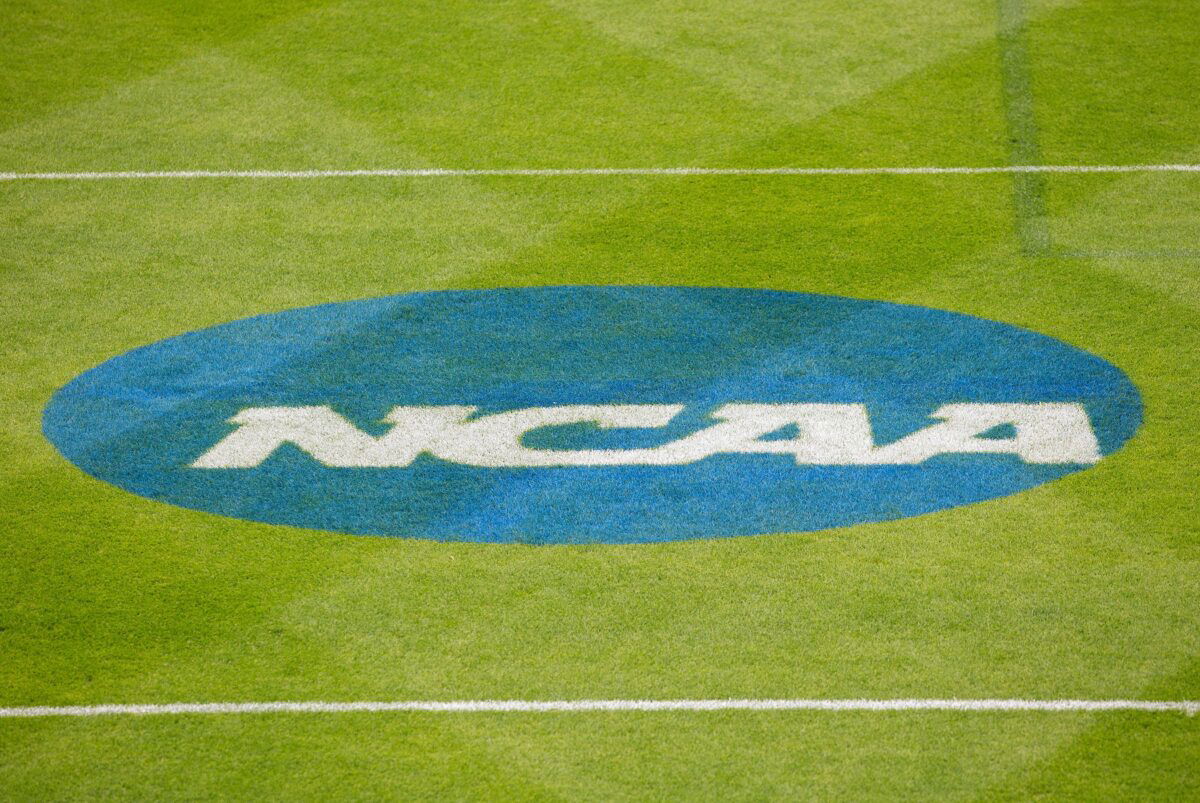
Imago
EAST HARTFORD, CT – MAY 19: General view of the NCAA, College League, USA logo prior to the Division 1 quarterfinal game between Loyola Greyhounds and Penn State Nittany Lions on May 19, 2019, at Rentschler Field in East Hartford, CT. (Photo by M. Anthony Nesmith/Icon Sportswire) NCAA LACROSSE: MAY 19 NCAA Lacrosse Championships Quarterfinals – Loyola v Penn State PUBLICATIONxINxGERxSUIxAUTxHUNxRUSxSWExNORxDENxONLY Icon19051913

Imago
EAST HARTFORD, CT – MAY 19: General view of the NCAA, College League, USA logo prior to the Division 1 quarterfinal game between Loyola Greyhounds and Penn State Nittany Lions on May 19, 2019, at Rentschler Field in East Hartford, CT. (Photo by M. Anthony Nesmith/Icon Sportswire) NCAA LACROSSE: MAY 19 NCAA Lacrosse Championships Quarterfinals – Loyola v Penn State PUBLICATIONxINxGERxSUIxAUTxHUNxRUSxSWExNORxDENxONLY Icon19051913
The age of the NCAA House settlement officially kicked off this week, ushering in a landscape shift unlike anything college sports have seen before. For the first time, schools are now free to directly pay student-athletes. This completely reshapes the foundational amateurism model that governed college athletics for more than a century. Beginning Tuesday, programs across the country could share up to $20.5 million annually with their athletes. But while most institutions are charging ahead into this new frontier, a small but notable group has chosen to stand on the sidelines, at least for now. Call them the opt-outs.
Watch What’s Trending Now!
The Ivy League was the first domino to fall earlier this year, taking a principled but predictable stance: all eight of its schools opted out of the NCAA settlement entirely. Citing their long-held policy of not awarding athletic scholarships. Military academies such as the Army, Navy, and Air Force were also excluded due to federal restrictions preventing athletes from profiting off NIL. But the true surprise came from a few Division I programs that had the choice and decided not to play ball. Among the handful of early-year opt-outs were Nebraska-Omaha and Montana. Two schools are offering starkly different justifications for the same decision.
Omaha cited concerns over Title IX compliance and the school’s core values during what they called a “transition to a new era.” In a public statement, the university wrote, “Although we welcome the approval and intent of the settlement, our mission remains to protect the interests of our current student-athletes while honoring UNO’s core values as we transition to a new era.” Translation: not quite yet. According to attorney Mit Winter, a prominent voice in college athletics law, the Title IX question looms large for many schools evaluating the financial and legal implications of doling out millions. “It’s a legitimate concern,” Winter said, particularly when schools face pressure to distribute payments equally across men’s and women’s sports.
ADVERTISEMENT
Montana’s decision hits differently. A perennial power at the FCS level, the Grizzlies aren’t strangers to competing at a high level, but they’re passing up the chance to share revenue this year. AD Kent Haslam pulled no punches in explaining why. “It’s not like we’ve been sitting on this extra pot of revenue that now, magically, we’ll be able to share,” Haslam told the Montana Kaimin in April. The money’s just not there. Meanwhile, Montana State—Montana’s in-state rival—opted in.
And that decision could tilt the recruiting playing field. As Winter put it, “It makes it much harder to compete in recruiting if schools you’re competing against are able to pay their athletes up to $20.5 million and you’re not able to pay them anything.” That sentiment cuts right to the heart of this new era. Even a one-year delay could come at a steep cost. Every recruiting cycle missed or class lost is a margin surrendered to programs willing to adapt more quickly. In CFB, where perception often matters as much as wins and losses, telling prospects you’re not quite ready to pay could be a deal-breaker.
And while some may paint this as an issue for smaller programs or schools with budgetary red tape, the truth is: competitive imbalance can affect any institution, regardless of tradition or history.
ADVERTISEMENT
D1 schools that opted in, but are stressed out
While a few schools have tapped the brakes on the NCAA’s House settlement, the overwhelming majority across Division I are hitting the gas. They’re opting in—not necessarily because they’re ready, but because they can’t afford not to. For these programs, the road ahead is filled with logistical speed bumps and legal landmines, but staying competitive in this new pay-for-play era means figuring it out on the fly.
ADVERTISEMENT
There’s a mad dash behind the scenes. Donor-backed NIL collectives that once operated in the shadows are now being absorbed into university frameworks. It’s a seismic shift in how schools fundraise, market athletes, and account for contracts that are starting to resemble NFL deals more than college scholarships. Schools must also now report NIL deals over $600, and that means administrators and athletes alike are being thrown into the deep end of contract law and compliance. Many of these programs won’t hit the $20.5 million cap allowed in athlete revenue sharing, which will only increase over time, but opting in still gives them a fighting chance.
“There are a lot of schools that feel the obligation to opt in to remain competitive,” said Michael Rueda, an attorney who leads the sports and entertainment division at Withers law firm. “I do think it offers a bit more structure for some of those larger schools… And then there are other schools that just aren’t in the same category. From a dollars-and-cents perspective, it just doesn’t make sense across the board.” For smaller schools in the NCAA, the financial gap isn’t shrinking; it’s growing wider by the day.
ADVERTISEMENT
ADVERTISEMENT
ADVERTISEMENT

